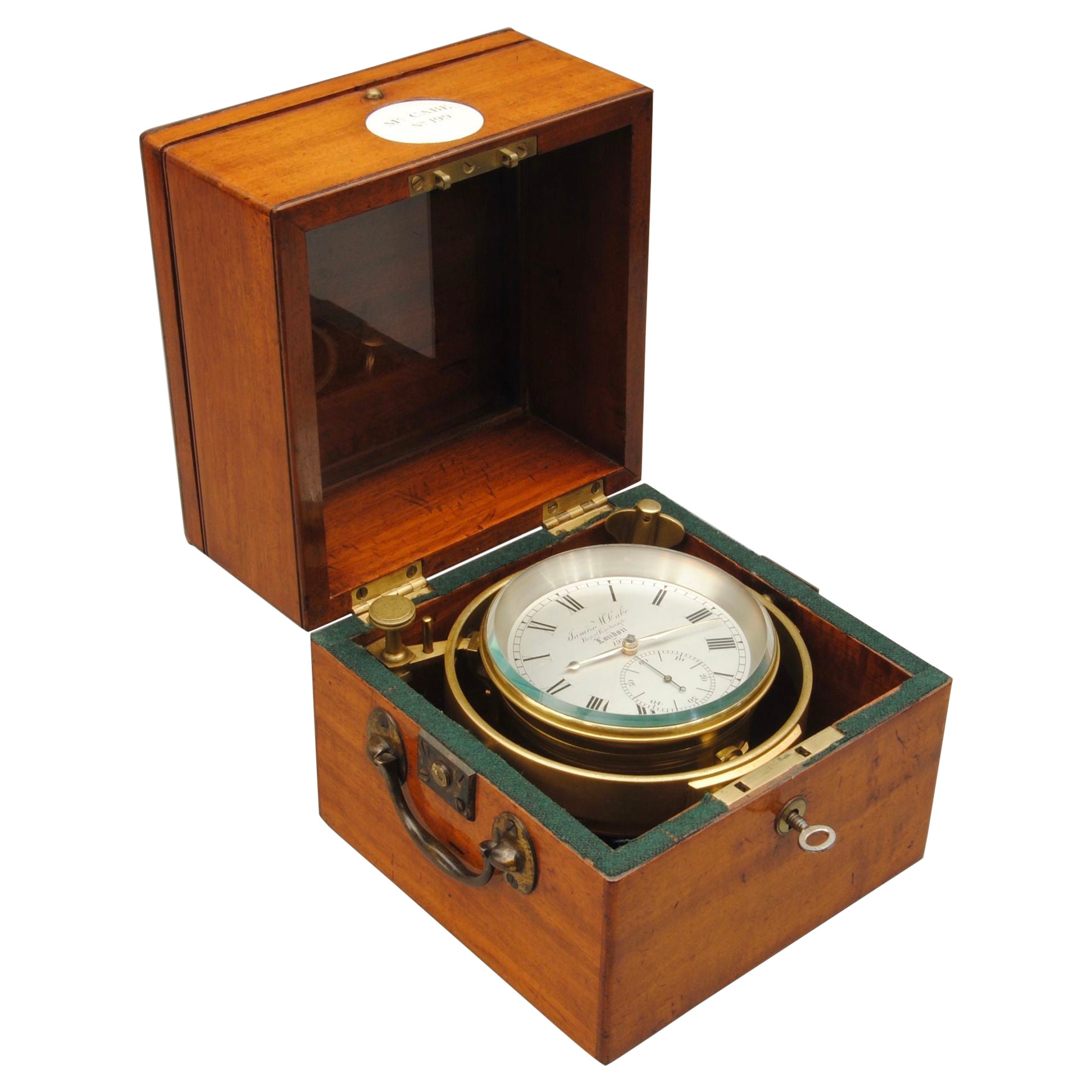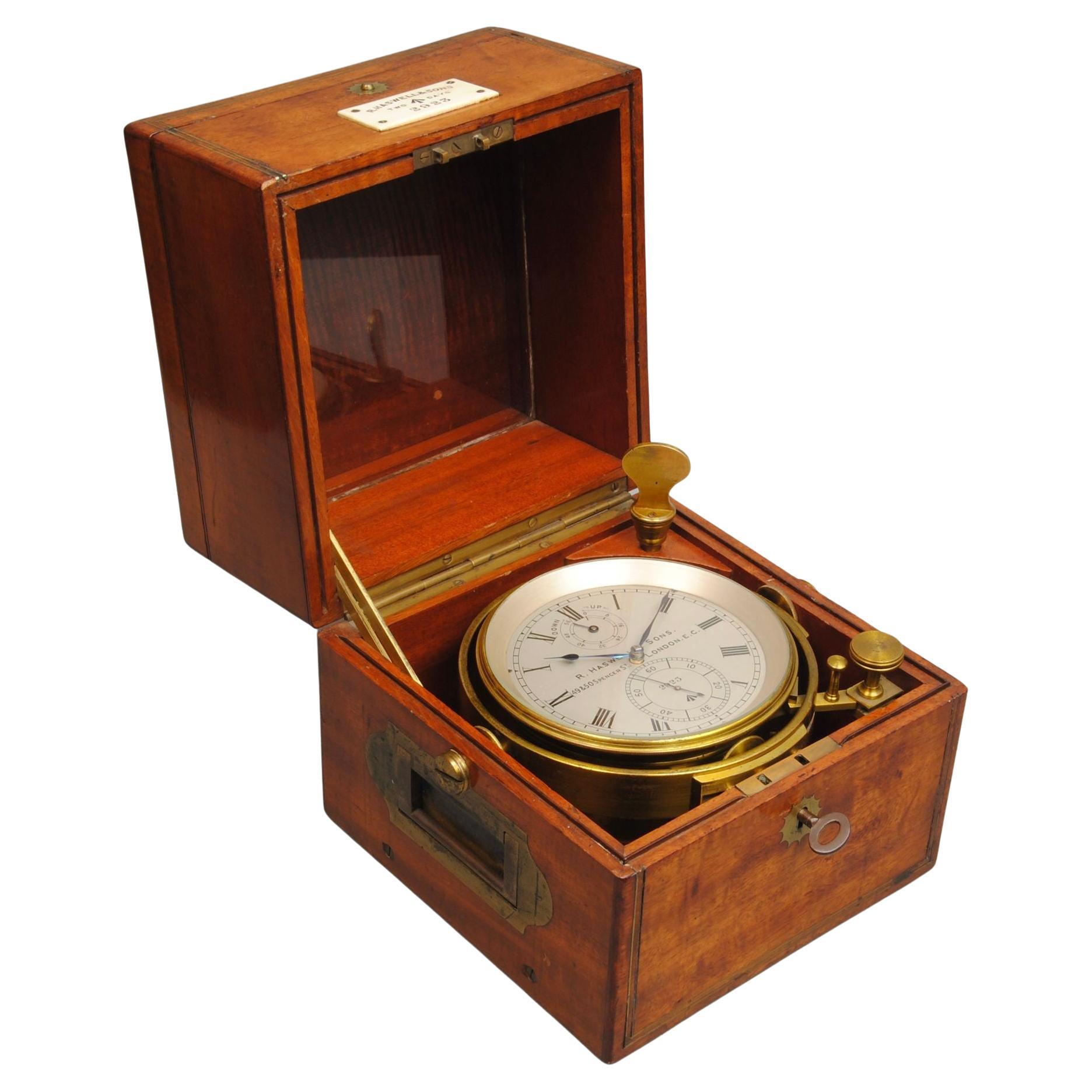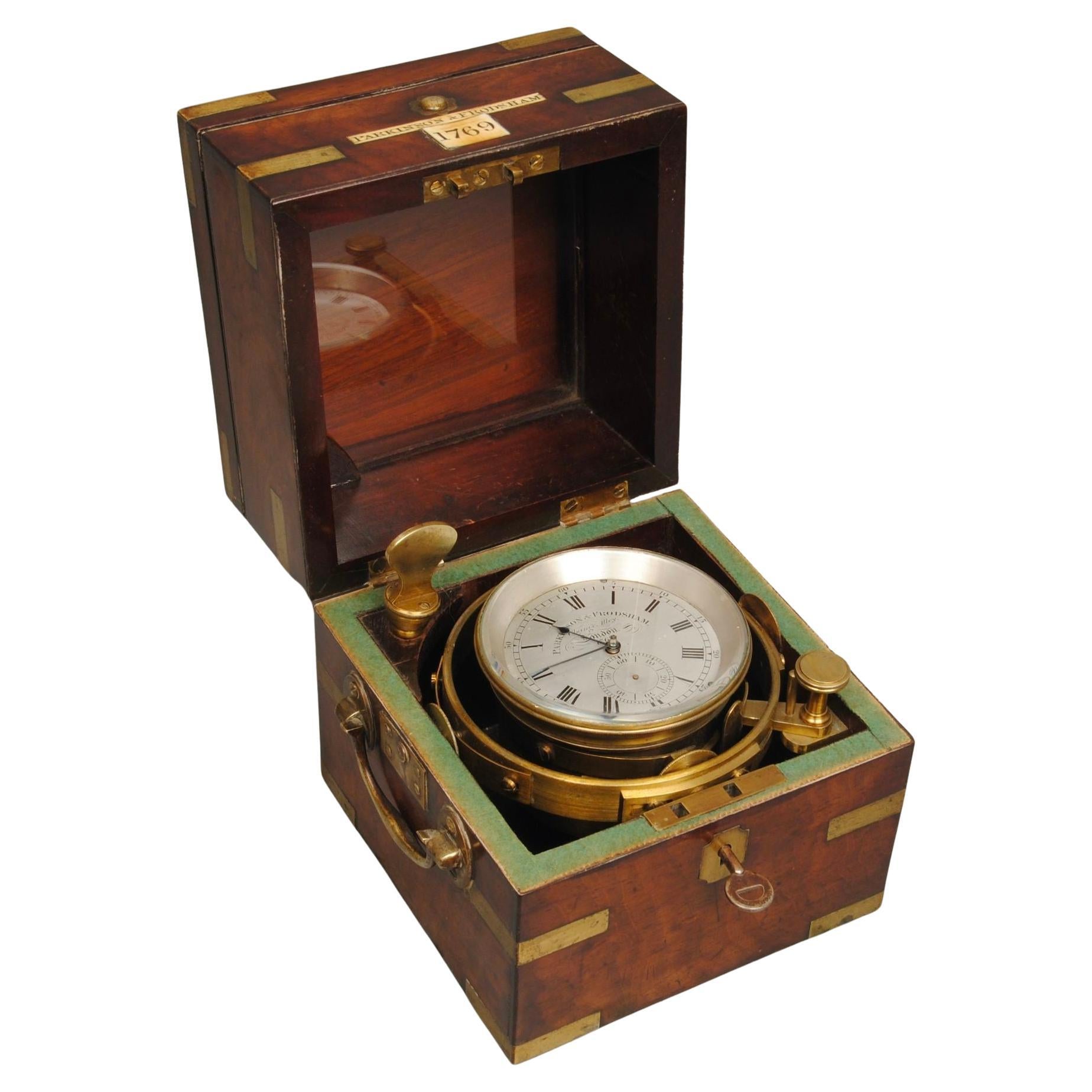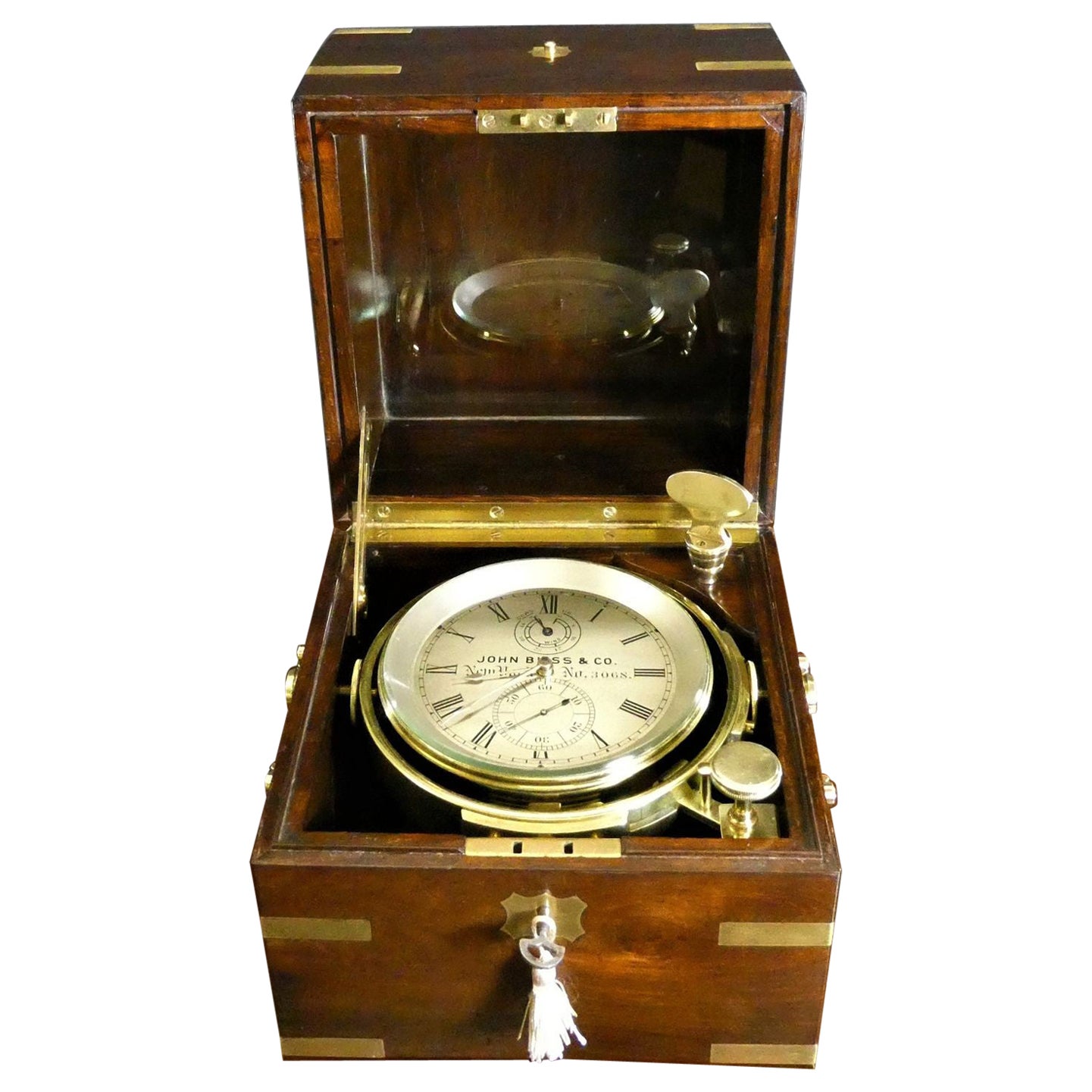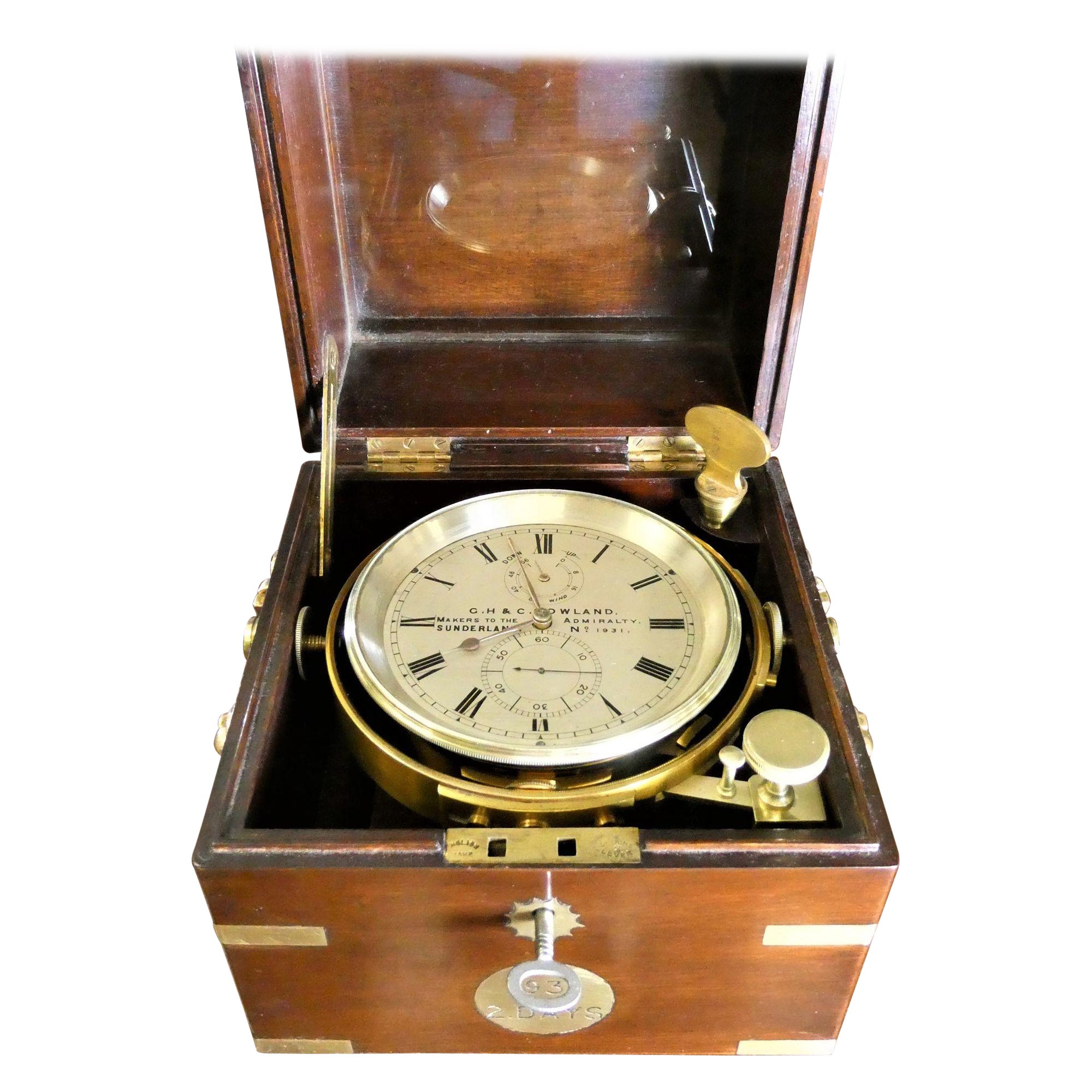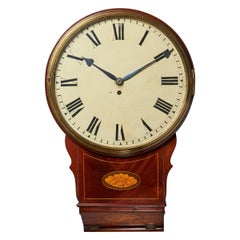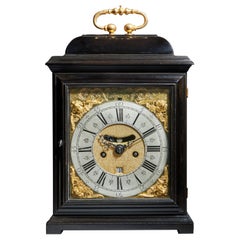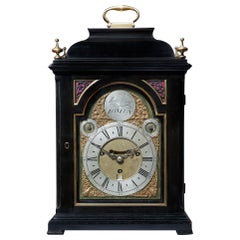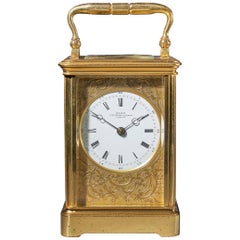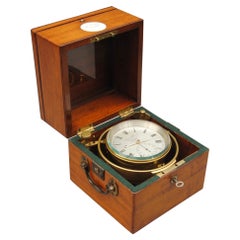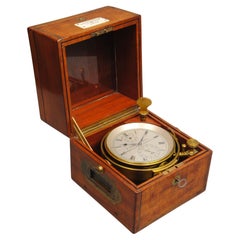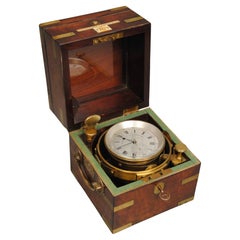Items Similar to Fine Scottish Two-Day Marine Chronometer Signed and Numbered D. McGregor
Want more images or videos?
Request additional images or videos from the seller
1 of 16
Fine Scottish Two-Day Marine Chronometer Signed and Numbered D. McGregor
$8,769.54
£6,500
€7,560.19
CA$12,261.95
A$13,400.88
CHF 7,051.97
MX$160,509.33
NOK 88,756.13
SEK 82,894.78
DKK 56,467.74
About the Item
A Fine Scottish Two-Day Marine Chronometer Signed and Numbered D. McGregor Glasgow No 2241, c. 1870
A classic beautifully produced 19th century Scottish chronometer in a three-tier mahogany case, made c. 1870. The typically constructed case consists of a lower and a glazed upper part, as well as a top lid. The lower part has two counter-sunk handles to the sides, while the front has a lock and key with an inlaid brass escutcheon. In the front of the upper part there is a brass button to lock the top lid. The movement is situated in a gimballed brass bowl, which can be secured for transport purposes by a turnable handle in the bottom right corner of the case. The 4" silvered dial is protected by a flat bevelled glass set in a brass bezel, screwed to the bowl. In addition, there is an original protective case, in which the chronometer can be placed to protect it from external hazards.
The maker has signed and numbered the chronometer on the silvered dial in the following manner:
D. McGregor & CO LTD
LIVERPOOL Glasgow
Greenock No 2241
The time is indicated by a fine pair of gilt brass hands on the silvered dial with a Roman chaptering, five-minute and minute divisions.
The seconds are indicated by a blued-steel hand on a separate chapter ring below the middle with Arabic ten-second, five-second and second divisions. Below the XII is up-and-down dial 0 - 56 (hours), indicating the state of winding.
The two-day duration movement is constructed between two circular engine-turned plates and is driven by a spring in a spring barrel via a chain fusee. It has a so-called Earnshaw spring detent escapement with a compensated balance and helical spring. The chronometer is wound by a special key with a ratchet to prevent winding the clock in the wrong direction. The key can be stored in a hole in the top right corner of the case. The winding hole is covered by a sprung shutter.
Dimensions: 18x18x18cm
The maker:
Duncan McGregor started his business in Greenock in 1836, opened premises in Glasgow in 1844 and traded as D. McGregor & Co. from 1856 onwards. Branches were opened in Liverpool in 1879 and London in 1886. They advertised themselves as manufacturers of nautical, mathematical and optical instruments, chronometers and watches. They often made use of famous chronometer makers such as Kulberg and Mercer.
Literature: Tony Mercer, Chronometer Makers of the World, p. 195
Jonathan Betts, Marine Chronometers at Greenwich, Oxford, 2017
- Creator:D. McGregor & Co. 1 (Clockmaker)
- Dimensions:Height: 7.09 in (18 cm)Width: 7.09 in (18 cm)Depth: 7.09 in (18 cm)
- Style:Victorian (Of the Period)
- Materials and Techniques:
- Place of Origin:
- Period:
- Date of Manufacture:1850
- Condition:Wear consistent with age and use. Fantastic condition throughout, in perfect order.
- Seller Location:Oxfordshire, GB
- Reference Number:1stDibs: LU4936233969192
About the Seller
5.0
Recognized Seller
These prestigious sellers are industry leaders and represent the highest echelon for item quality and design.
1stDibs seller since 2019
24 sales on 1stDibs
Typical response time: 14 hours
Associations
LAPADA - The Association of Arts & Antiques Dealers
- ShippingRetrieving quote...Shipping from: Faringdon , United Kingdom
- Return Policy
More From This Seller
View AllFine English Drop Dial Wall Clock, Circa 1840
Located in Oxfordshire, United Kingdom
A lovely and attractive English trunk dial clock made c. 1840.
The mahogany veneered case is of an original design with slightly shaped sides to the trunk and a Sheraton-like she...
Category
Antique 19th Century English George IV Wall Clocks
Materials
Mahogany
A rare 17th century English eight-day spring-driven table clock by J Gerrard
Located in Oxfordshire, United Kingdom
A Rare Late 17th Century English Eight-Day Spring-Driven Table Clock, Circa 1700. England
Signed J. Gerrard.
This exceptional late 17th-century English eight-day table clock is a s...
Category
Antique 17th Century English William and Mary Table Clocks and Desk Clocks
Materials
Brass
Rare 18th Century George II Musical Table Clock by Matthew King, circa 1735
Located in Oxfordshire, United Kingdom
A rare George II musical table clock by Matthew King, circa 1735.
This unusual eight-day spring-driven table clock was made by Matthew King, wh...
Category
Antique 18th Century English George II Table Clocks and Desk Clocks
Materials
Silver, Brass
Striking 19th Century Carriage Clock with a Gilt-Brass Corniche Case by Grohé
Located in Oxfordshire, United Kingdom
Striking carriage clock with a gilt-brass corniche case by Grohé, circa 1880.
A most attractive eight-day striking carriage clock, signed on...
Category
Antique 19th Century French Neoclassical Carriage Clocks and Travel Clocks
Materials
Brass
18th Century George III Figured Mahogany Three Pad Stricking Bracket Clock
Located in Oxfordshire, United Kingdom
18th century George III figured mahogany three pad bracket clock by John Wright Dorking, Circa 1780. England
A most attractive English bracket clock, made around 1780, signed on ...
Category
Antique 18th Century English George III Table Clocks and Desk Clocks
Materials
Brass
A 17th Century William and Mary eight-day table clock by Isaac Lowndes, 1695
Located in Oxfordshire, United Kingdom
A fine William and Mary eight-day spring-driven table clock signed on the backplate, Isaac Lowndes Pallmall Court, c.1695.
The elegantly proportioned ebony-veneered oak domed top c...
Category
Antique 17th Century English William and Mary Table Clocks and Desk Clocks
Materials
Brass
You May Also Like
Early 19th Century 2 Day Marine Chronometer by James McCabe, No. 199
By James McCabe
Located in Lincolnshire, GB
Number 199, a two day marine chronometer by James McCabe, London, beautifully signed and numbered on the dial and movement, and the number on the bottom of the bowl. In a three part ...
Category
Antique Early 19th Century English Scientific Instruments
Materials
Brass
A Fine Marine Chronometer by Haswell And Sons NO. 2923 With Interesting History
Located in Lincolnshire, GB
A two day marine chronometer in the original brass bound mahogany case.
Purchased by the Admiralty in 1895, it was 27th in the annual trial of chronometers at the Royal Observatory, ...
Category
Antique Late 19th Century English Nautical Objects
Materials
Brass
A Fine Early 19th Century Marine Chronometer By Parkinson And Frodsham
Located in Lincolnshire, GB
An early 19th century 2 day marine chronometer by Parkinson and Frodsham, London. Numbered on the brass bound mahogany 3 tier box, and the dial ...
Category
Antique Early 19th Century English Scientific Instruments
Materials
Brass
Two Day Marine Chronometer, John Bliss, New York
By John Bliss & Co.
Located in Norwich, GB
A Fine Two Day Marine Chronometer By John Bliss and Co, New York. No.3068
Two day marine chromometer by John Bliss and Co housed in a beautiful three tier brass bound box with brass carrying handles to the sides, brass push button knob opening to a third tier. The box has a wonderful rich patina and retains it’s original solid brass Tipsy key.
The movement is housed within a gimballed brass surround which is stamped H.M.I and marked with the ordnance arrow
The high quality 56 hour chain fusee movement has full brass plates joined by four ringed pillars, an Earnshaw-type spring detent escapement with maintaining power, split bi-metallic balance and cylindrical shaped temperature compensation weights, polished steel helical balance and faceted endstone.
The silvered dial signed ‘John Bliss & Co, New York No 3068 with subsidiary dial below XII for ‘state of wind’ and subsidiary seconds dial above the VI, original ‘blued’ steel hands. C.1890
John Bliss & Co worked at 128 Front Street, New York between 1880 and 1929 and then 84 Pearl Street, New York from 1934 to 1939. Front Street runs from the Brooklyn Bridge to Hudson Ave. and Navy Street, close to the Docks area. On the death of John Bliss, his sons John and George carried on the business. Their chronometers were placed 3rd, 6th and 8th at the Washington Observatory Trials in 1886. They became suppliers to the US Navy and also made meteorological instruments and devised an original way of making mainsprings. Many of their movements were supplied by makers in England, particularly Victor Kullberg.
Category
Antique 1890s English Nautical Objects
Materials
Brass
Antique Chronometer Clock J. Sewill Liverpool Marine Royal Navy Box
Located in Potters Bar, GB
You are viewing a collectable antique chronometer by J. Sewill of Liverpool
Circa 1880 on this amazing marine antique
The chronometer is housed in its original glazed three-tier maho...
Category
Antique 1880s Victorian Mantel Clocks
Materials
Mahogany
Two Day Marine Chronometer, G.H & C Gowland, Sunderland No.1931
Located in Norwich, GB
A fine two Day Marine Chronometer by G.H & C Gowland, Sunderland No. 1931
Two day marine chromometer by G.H & C Gowland housed in a beautiful three tier mahogany brass bound box...
Category
Antique 1870s English Nautical Objects
Materials
Mahogany
More Ways To Browse
Antique Bronze Watch
Blue Table Clocks
Cartier Clock Art Deco
Leather And Brass Desk Clock
Art Deco Bakelite Clocks
Shagreen Galuchat
Swiss Alarm Clock
Vintage Alarm
Vintage Atmos Clock
Antique German Table Clocks
Brass Skeleton Clock
Calendar Clock
Automaton Clock
Blue Enamel Clock
Purple Clock
White Table Clock
Mid Century Modern Lucite Clocks
Murano Glass Clocks
